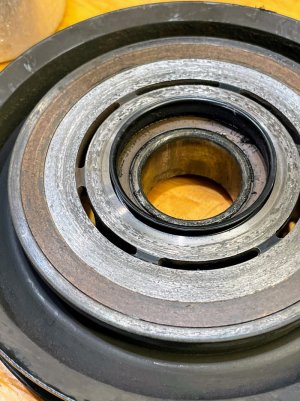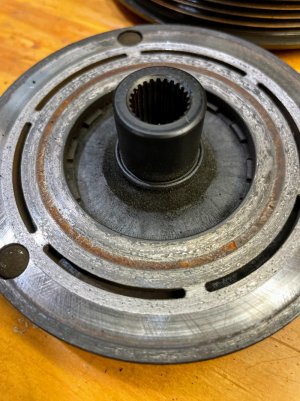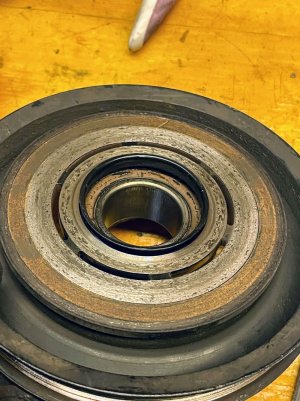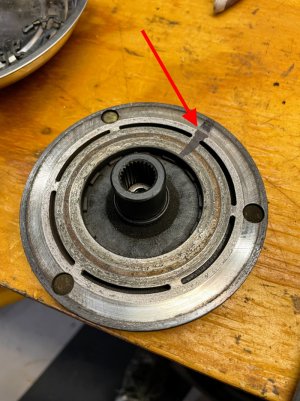Just like the MT CL (clutch), how you engaged the A/C would be the main factor for the lifespan.
For example, when I was in Japan, it was mainly stop-and-go traffic with occasional spirited mountain driving so used to replace the friction discs every 30K miles.
On the other hand, since moved to UK, not much traffic jam around where I live and never had to use parking brake on launch as enough torque can be generated even at the steep slope.
In UK, I can easily cover more than 100K miles on the same friction discs compared to just 30K miles in Japan.
For the same reason, switching On and Off the A/C CL at idle rpm is not the same as doing so in VTEC region.
So, whether you can re-use your existing A/C CL assy highly depends on how you used your A/C and how you are likely to use it in the future.
For the quick check, just re-assemble the CL pulley, the pressure plate including the spacer shim, tighten the 10mm fixing bolt and measure the clearance.
If the CL has worn out, you would be close to the limit of the clearance (wider clearance) or even worse, already out of the spec (too much clearance).
If that is the case, unless the pressure plate shows blue heat spot or the friction material of the CL pulley has broken down, as a temporary measure, you can adjust the shim thicknes to keep it going.
Obviously, you will need to repeat the same process later when the time has come to replace the CL assy.
Look for the blue spot or uneven wear on the mating surface of the pressure plate (2nd photo in your post).
As you can see in your photo, the pressure plate has the spline and connected to the compressor shaft by thread locked 10mm bolt with one or few shims being sandwiched to create the specified clearance.
At the other side (outer surface, hidden in your photo), there is a rubber damper section.
When the field coil is energised and generated the magnetic field, the rubber damper will let the pressure plate pulled towards the CL pulley engaging the engine power to compress the A/C refrigerant.
If the CL worn out (actually the pressure plate) and slipped, it will cause blue heat spot and some squeaking noise when it gets really bad.
If you ignore it, the entire CL assy gets really hot and it will melt the resin body of the field coil so don't push too much with worn CL assy.
There is few mm thickness/layer of friction material band on the CL pulley.
Unless you have other mechainical failure such as rattling bearing, if the assy is worn out, you will see huge increase in the clearance.
Just look from the top while the engine is stopped.
If the clearance is no longer there and the pressure plate tends to touch the CL pulley, check the bearing or look for any damages on the pressure plate around the rubber damper.
Looks like you've cleaned the bearing section a little so flip over to the other side and look for any splashed grease.
Feel for any rattle or roughness to check the state of the bearing.
Never had to do so on NSX but may be good idea to replace the pulley bearing if re-using it.
Quite surprised that the OEM CL assys was NLA.
The R12 spec (-003) is NLA for quite some time but not the pre-97 R134a one (-A03).
Probably true in US but did you check with the vendors in Japan?
Should be available but don't know the delivery charge these days due to limited cargo space.
For the aftermarket one, I'm afraid I don't know the replacement with the pre-97 offset.
As a side note, the 97+ offset Denso reman compressor
#471-1193 is on long back order.
You can still get pre-97 offset
#471-1194 but as you know, the pulley diameter is too small.
A while ago on UK forum - nsxcb.co.uk, the user 'wixer' posted that the CL assy from 4Seasons
#47598 has the 97+ offset.
So, if you have access to the 97+ mounting bracket and if you can't wait for the
#471-1193 to be back in stock, you could get
#471-1194 and swap the pulley using the 4Seasons one.
Though, kind of waste for not using the brand new CL pulley that came with
#471-1194 but at wrong pulley diameter.
Any way, I'm in the similar situation for one owner so went ahead and got the 4Seasons
#47598 .
Just going to wait for awhile before placing the order for the compressor in a hope that
#471-1193 becomes back in stock again.
Here is what you will get with the 4Seasons
#47598 .
Correct diameter at 140mm, 97+ offset pulley,
wrong connector and too short cable length but just extend it using the existing OEM one.
Or, if the OEM field coil is not melted, just re-use it.
I'll just post the photo here so that you can see how it looks when new.
Kaz










